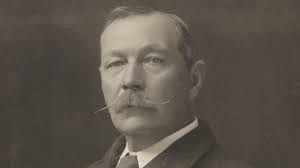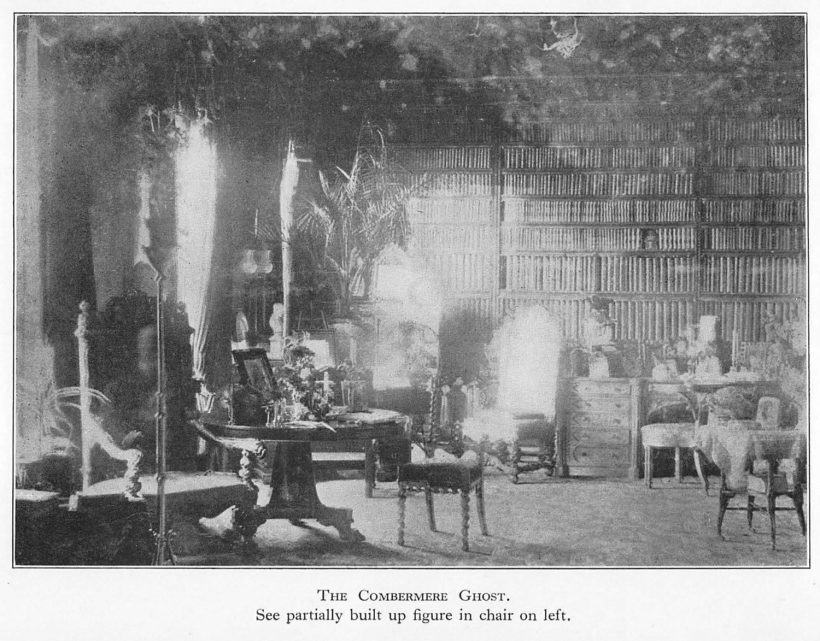Lord Combermere (1773-1865) was a distinguished British Cavalry commander in the early 1800s. Combermere Abbey, Cheshire, England, was founded by Benedictine monks in 1133. King Henry Vll kicked the Benedictines out and ultimately the Abbey came into Lord Combermere’s ancestral family from whence he took his title. Today it is both a tourist attraction and hotel.
In 1817 Lord Combermere became Governor of Barbados. While Governor he ordered an investigation of the “Moving Coffins”. Apparently the Chase family vault was sealed, the heavy coffins left in “proper order”, yet when a new coffin was added the coffins were discovered to be “strewn about”, perhaps by unnatural forces. It appears to have remained a mystery.
Many years later, in 1891, Lord Combermere’s son, born in 1818, also Lord Combermere, at age 73, was struck and killed by a horse-drawn carriage. One story, of high interest, tells us that while the Lord’s funeral was underway, a photographer, Sybell Corbet, Lady Combermere’s sister who was staying at the Abby at the time and presumeably did not attend her brother-in-law’s funeral, was 4 miles away taking a photo of the Combermere Abbey library for some unexplained reason. A figure of a man can be faintly seen sitting in a chair – his head, collar and right arm on the armrest quite discernable. It is said to be one of the best photos of a ghost ever taken for it is believed to be Lord Combermere’s ghost (the son).
Corbet recorded that the photographic exposure took one hour. Some thought perhaps a servant had slipped in and sat briefly in that same chair but members of the household said they were all at the funeral. The staff said the image appeared to be Lord Combermere and he was sitting in his favorite chair. Who said history is dull?
The Combermere Photograph
The Combermere Photograph is an article written by Arthur Conan Doyle published in Psychic Science in october 1926.
(The photograph in question was shown during a public lecture given by the writer in the Queen’s Hall, London, in the spring of the present year.)

There has been some public argument recently about the so-called Combermere photograph. It has seemed to me that while the matter is still more or less fresh in the minds of psychic students, it would be well to place the facts upon record. They are of great importance, for though it has never been claimed that they are absolutely final — how few things are absolutely final in this world! — they do, so far as my experience goes, constitute the best case upon record of supernormal photography in ordinary life, without the use of the peculiar atmosphere of a developed psychic photographer.
The photograph, which is here reproduced, was sent to me by the courtesy of the present Lord Combermere, with permission that I should use it as a slide in my lecture upon spirit photography. Upon the back of it were inscribed the words “The Ghost of Combermere Abbey, This photograph was taken of the Library by Miss Corbet, on Dec. —, 1891, on the afternoon of the funeral of Wellington Henry, 2nd Viscount Combermere. The figure in the chair on the left of the photograph (legless) is supposed to be a likeness of him.”
In my lecture it was one of fifty others, and as I had only a minute or two to devote to each I simply gave the information recorded, without making any claim to personal knowledge upon the point, but the subsequent discussion has cleared matters up and the various possibilities have been met in such a way as to strengthen greatly the position of the photograph as an abnormal phenomenon.
Some days after the lecture, Mr. Campbell Swinton published a letter attacking the photograph, challenging its authenticity, and even permitting himself to use such terms as “photographic fraud.” Mr. Swinton had not been present at the lecture, and clearly had no idea of the restrained way in which I had treated the subject. His violent onslaught however, had a very excellent effect as it brought about a fuller discussion and a more complete vindication than could in any other way have been obtained. In the long series of comments which followed, it is probable that we tapped every available source of information and are now in a position to sum up the argument.
It appears that after Lord Combermere’s death, a family named Corbet was living at the Abbey. One member of the family, now Mrs. Hubert Astley, and formerly Lady Sutton, desired to have a photograph of the Library, and asked her sister, Miss Sybil Corbet, to take one. As it was winter there was a considerable time exposure, and Miss Corbet seems to have left the room in the course of it. There was no man in the house at the time save a younger brother, and the men-servants all of whom were clean shaven. The photograph was not developed for some months, because the Corbets were in the act of changing house. When developed, this figure of a man was found seated in one of the armchairs. The print, according to Mrs. Astley, was to the best of her belief sent to Lady Alexander Paget, who said, “It is my father. It is just the type of collar he wore, but the features are not distinct.”
It is undoubtedly true that the features are very vague. Only two points can be stated with any certainty, that the forehead is high and bald, and that there is some appearance of beard. The question then arises whether Lord Combermere’s face had these characteristics. Through the courtesy of Mr. Campbell Swinton, a picture of Lord Combermere was sent to a daily paper, and it will be seen that both these points as well as the general outline of the face, are the same in the deceased peer and in the shadowy image.
In view of the photographer having left the room it becomes very important to find out if there was anyone else who possessed these facial peculiarities and who could have sat down in the chair. A butler has been suggested, but we are expressly told that the men servants were clean shaven. The Rev. Athelstan Corbet (the similarity of name appears to be a coincidence), has suggested that there was an old Estate carpenter who resembled the peer, and that he may have walked into the room, sat down for a while, and then left. To this Mrs. Astley has objected that this clergyman was never, so far as she knew, at Combermere, and that she has no recollection of any carpenter upon the estate who bore a resemblance to the deceased nobleman. Apart from this there is the inherent improbability, amounting almost to an impossibility, that in any well-ordered household either a butler or a carpenter would walk into a room which was being used by the family and seat himself in an armchair. A further question would be that if it were so there is no possible reason why the trunk of the figure should be visible and the legs not. If it were a partial materialization such a result could be explained. One would also imagine that the movement of a figure to and from the chair would have caused some slight blur upon even the unsensitive plates of those earlier days. There is no trace of anything of the sort.
There has been some conflict of opinion as to whether the room is the Library or the Hall. It is really of no importance since it is obviously a large room lined with books and furnished as a sitting room. I am inclined however, to think that the inscription upon the back of the photograph which says that it was taken on the day of the funeral is mistaken. It was taken, I believe, upon a Sunday afternoon shortly after the nobleman’s decease. There is a conflict of evidence upon this point.
Let us now consider the various possibilities in this case. We will put aside as absurd and outside the discussion that Miss Corbet could have manipulated the plate so as to produce the figure. Since the figure is clearly there it has to be accounted for. Mr. Swinton began by describing it as a photographic defect, but one can clearly see that it is not so, and that the figure is quite definite. Was it some stranger who slipped into the empty room, sat in front of the open lens, and then got away unseen. If so unlikely a thing had occurred the person must have afterwards heard of the speculations as to the figure, and there seems no reason why he should not confess since the offence was a venial one. Other reasons against the theory of an interloper have already been given. Such an explanation is not impossible, but it is to the last degree improbable.
There only remains the explanation of the semi-materialised simulacrum of the dead man. Such appearances in the absence of any obvious medium, are rare but by no means unique. I could match it with several other examples in my collection. It has been objected by one psychic student that the fact that the light effects are normal is against such a supposition. The exact opposite is the case. It is true that in the case of a psychograph as obtained in the presence of a psychic photographer the result is an impression which is independent of light. In the case however, of a materialisation one would expect all the effects as from a solid object. The fact that there was no medium in the room has no significance as the ectoplasm or other material necessary for the process can in such cases be obtained from elsewhere. It is likely that on a Sunday afternoon there may have been sleepers in the household whose forces could be used. If these forces were not entirely sufficient we could understand the absence of legs. It may be worth mentioning that it is stated that the deceased peer lost the use of his legs some time before his death, and that their absence in the photograph may be symbolical and evidential.
So there the matter must rest and the reader use his own judgment. I end as I began by expressing my opinion that the ghost theory is far the more probable and that the incident is the best authenticated one of the sort in the history of psychic research.
ARTHUR CONAN DOYLE.
